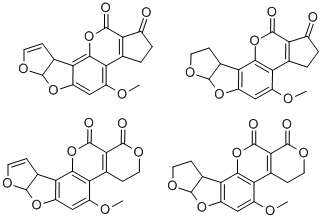Aflatoxins are naturally occurring bisfuranocoumarin compounds
produced from the molds Aspergillus flavus and Aspergillus
parasiticus. The aflatoxins are highly fluorescent. The B refers
to blue and the G signifies green fluorescence. M aflatoxins are
fungal metabolites present in milk. Aflatoxin B1 is the most
common and potent of the aflatoxins. Crops that are affected by
aflatoxin contamination include cereals (maize, sorghum, rice,
wheat), oilseeds (peanut, sunflower, soybean, cotton), spices
(chili peppers, black pepper, coriander, turmeric, ginger), and
tree nuts (almond, coconuts, brazil nuts, walnuts, pistachio).
Aflatoxin can also be found in the milk, eggs, and meat from
animals fed contaminated feed.
The aflatoxins are a group of molds produced by the fungus Aspergillus flavus. They are natural contaminants of fruits, vegetables, and grains. They are also described as a series of condensed ring heterocyclic compounds. They form colorless to pale yellow crystals. Practically insoluble in water.
Aflatoxins are used solely for research purposes. They are naturally occurring contaminants formed by certain fungi on agricultural crops, first discovered in the 1960s (IARC 1976).
Toxic metabolites produced by fungi.
Confirmed human carcinogen with experimental tumorigenic data. Human poison by ingestion. An experimental teratogen. Other experimental reproductive effects. Mutation data reported. See also various aflatoxins
Aflatoxins are a group of toxic metabolites produced by certain types of fungi. Aflatoxins are not commercially manufactured; they are naturally occurring contaminants that are formed by fungi on food during conditions of high temperatures and high humidity. Most human exposure to aflatoxins occurs through ingestion of contaminated food. The estimated amount of aflatoxins that Americans consume daily is estimated to be 0.15 0.50 μg. Grains, peanuts, tree nuts, and cottonseed meal are among the more common foods on which these fungi grow. Meat, eggs, milk, and other edible products from animals that consume aflatoxincontaminated feed may also contain aflatoxins. Aflatoxins can also be breathed in
Aflatoxins are known to be human carcinogens based on sufficient evidence of carcinogenicity from studies in humans. Aflatoxins were listed in the First Annual Report on Carcinogens as reasonably anticipated to be human carcinogens based on sufficient evidence of carcinogenicity from studies in experimental animals and limited evidence of carcinogenicity from studies in humans; however, the listing was revised to known to be human carcinogens in the Sixth Annual Report on Carcinogens in 1991.
Aflatoxin B1 is metabolized to a reactive epoxide (aflatoxin
8,9-epoxide) primarily by the P450 monooxygenase
system. In humans, the epoxidation reaction is catalyzed by
CYP1A2 and CYP3A4. Once formed, the epoxide can react
further to form DNA adducts (aflatoxin-N7-guanine) and
induce mutations and cancer. Alternatively, the epoxide can
be detoxified by conjugation with glutathione through the
actions of certain glutathione S-tranferases. Rats are more
susceptible than mice to aflatoxin hepatocarcinogenesis
even though both species form the reactive 8,9-epoxide at
similar rates. Differences in species susceptibility are
hypothesized to relate to increased rates of glutathione
conjugation to the aflatoxin 8,9-epoxide in mice compared
to rats.
UN3172 Toxins, extracted from living sources, solid or liquid, Hazard Class: 6.1; Labels: 6.1-Poisonous materials, Technical Name Required. UN2811 Toxic solids, organic, n.o.s., Hazard Class: 6.1; Labels: 6.1-Poisonous materials, Technical Name Required.
Aflatoxin will exist solely in the particulate phase if released
into the ambient atmosphere based on estimated vapor pressure
values (1.6 ×10�-10 to 7.7×10��-11mmHg) at 25°C.
Particulate-phase aflatoxins would be expected to be removed
from the atmosphere by wet and dry deposition. Direct
photolysis is also possible since aflatoxins absorb light in the
environmental UV spectrum. If released to soil, the aflatoxins
are expected to have high to slight mobility based upon Koc
values of 3974, 263, and 116. Aflatoxins are not expected to
volatilize from dry soil surfaces based upon their vapor pressures.
If released into water, the aflatoxins may adsorb to suspended
solids and sediment based upon the available Koc
values. Estimated BCF values of 2–3 suggest the potential for
bioconcentration in aquatic organisms is low. Aflatoxin may
also be degraded by photolysis at soil and water surfaces.
Incompatible with oxidizers (chlorates, nitrates, peroxides, permanganates, perchlorates, chlorine, bromine, fluorine, etc.); contact may cause fires or explosions. Keep away from alkaline materials, strong bases, strong acids, oxoacids, epoxides.
Consult with environmental regulatory agencies for guidance on acceptable disposal practices. Generators of waste containing this contaminant (≥100 kg/mo) must conform with EPA regulations governing storage, transportation, treatment, and waste disposal. Use of oxidizing agents, such as hydrogen peroxide or 5% sodium hypochlorite bleach. Acids and bases may also be used.
